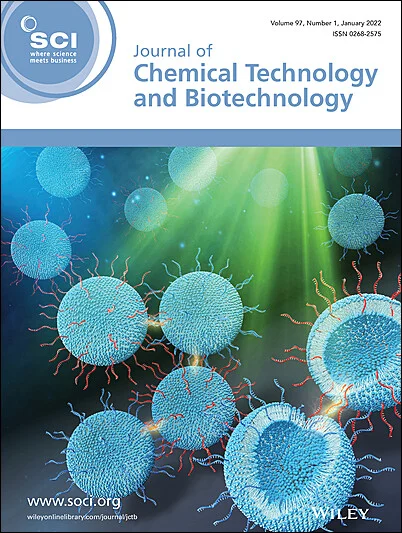Yajing Wang, Jisheng Li, Caixiong Quan, Shiying Di, Siqi Jiang, Zhiyuan Wang, Ningning Wang, Jiahui Zhang, Xin Guo, Yufeng Hu
求助PDF
{"title":"盐湖卤水中硼高萃取效率的机理研究:动力学、传质和建模","authors":"Yajing Wang, Jisheng Li, Caixiong Quan, Shiying Di, Siqi Jiang, Zhiyuan Wang, Ningning Wang, Jiahui Zhang, Xin Guo, Yufeng Hu","doi":"10.1002/jctb.7852","DOIUrl":null,"url":null,"abstract":"<div>\n \n \n <section>\n \n <h3> BACKGROUND</h3>\n \n <p>The kinetic study of boron extraction from Salt Lake brine is the essence and mechanism of solvent extraction process. A thorough understanding of the kinetic competition between desired Ionic liquid (IL)-isooctyl alcohol (2-EH) extraction processes and any detrimental diffusion resistance is required to achieve high extraction efficiency of boron in Salt Lake brine.</p>\n </section>\n \n <section>\n \n <h3> RESULTS</h3>\n \n <p>The extraction experiments of boron from Salt Lake brine with highly extraction efficiency (93.6%) in 3-dodecyl-1-methylimidazolium hydrogen sulfate ([C<sub>12</sub>mim][HSO<sub>4</sub>])-2-EH extraction system was performed in a constant interfacial area stirred Lewis cell. The work uniquely employs a laminar constant interface surface cell as the research object, offering a more precise measurement of the extraction kinetics compared to traditional methods. Furthermore, the impacts of key parameters such as extraction temperature, stirring speed, phase interface area, and the initial concentrations of boron [C<sub>12</sub>mim][HSO<sub>4</sub>] and 2-EH were thoroughly examined, revealing their significant influence on extraction efficiency.</p>\n </section>\n \n <section>\n \n <h3> CONCLUSION</h3>\n \n <p>The results showed that the extraction process mainly occurred in the two-phase interfacial region and was controlled by aqueous diffusion reaction. The activation energy was determined to be about 23.90 kJ·mol<sup>−1</sup>. Meanwhile, thermodynamic parameters (Δ<i>H</i>, Δ<i>S</i>, and Δ<i>G</i>) revealed that the extraction of boron was an endothermic and non-spontaneous process. According to data analysis, boron extraction is approximately first-order, and a novel rate equation and extraction mechanism are proposed. The results will provide referential values for the development of more efficient separation processes. © 2025 Society of Chemical Industry (SCI).</p>\n </section>\n </div>","PeriodicalId":15335,"journal":{"name":"Journal of chemical technology and biotechnology","volume":"100 6","pages":"1213-1221"},"PeriodicalIF":2.8000,"publicationDate":"2025-03-27","publicationTypes":"Journal Article","fieldsOfStudy":null,"isOpenAccess":false,"openAccessPdf":"","citationCount":"0","resultStr":"{\"title\":\"Toward mechanistic understanding of highly extraction efficiency for boron from Salt Lake brine: kinetics, mass transfer, and modeling\",\"authors\":\"Yajing Wang, Jisheng Li, Caixiong Quan, Shiying Di, Siqi Jiang, Zhiyuan Wang, Ningning Wang, Jiahui Zhang, Xin Guo, Yufeng Hu\",\"doi\":\"10.1002/jctb.7852\",\"DOIUrl\":null,\"url\":null,\"abstract\":\"<div>\\n \\n \\n <section>\\n \\n <h3> BACKGROUND</h3>\\n \\n <p>The kinetic study of boron extraction from Salt Lake brine is the essence and mechanism of solvent extraction process. A thorough understanding of the kinetic competition between desired Ionic liquid (IL)-isooctyl alcohol (2-EH) extraction processes and any detrimental diffusion resistance is required to achieve high extraction efficiency of boron in Salt Lake brine.</p>\\n </section>\\n \\n <section>\\n \\n <h3> RESULTS</h3>\\n \\n <p>The extraction experiments of boron from Salt Lake brine with highly extraction efficiency (93.6%) in 3-dodecyl-1-methylimidazolium hydrogen sulfate ([C<sub>12</sub>mim][HSO<sub>4</sub>])-2-EH extraction system was performed in a constant interfacial area stirred Lewis cell. The work uniquely employs a laminar constant interface surface cell as the research object, offering a more precise measurement of the extraction kinetics compared to traditional methods. Furthermore, the impacts of key parameters such as extraction temperature, stirring speed, phase interface area, and the initial concentrations of boron [C<sub>12</sub>mim][HSO<sub>4</sub>] and 2-EH were thoroughly examined, revealing their significant influence on extraction efficiency.</p>\\n </section>\\n \\n <section>\\n \\n <h3> CONCLUSION</h3>\\n \\n <p>The results showed that the extraction process mainly occurred in the two-phase interfacial region and was controlled by aqueous diffusion reaction. The activation energy was determined to be about 23.90 kJ·mol<sup>−1</sup>. Meanwhile, thermodynamic parameters (Δ<i>H</i>, Δ<i>S</i>, and Δ<i>G</i>) revealed that the extraction of boron was an endothermic and non-spontaneous process. According to data analysis, boron extraction is approximately first-order, and a novel rate equation and extraction mechanism are proposed. The results will provide referential values for the development of more efficient separation processes. © 2025 Society of Chemical Industry (SCI).</p>\\n </section>\\n </div>\",\"PeriodicalId\":15335,\"journal\":{\"name\":\"Journal of chemical technology and biotechnology\",\"volume\":\"100 6\",\"pages\":\"1213-1221\"},\"PeriodicalIF\":2.8000,\"publicationDate\":\"2025-03-27\",\"publicationTypes\":\"Journal Article\",\"fieldsOfStudy\":null,\"isOpenAccess\":false,\"openAccessPdf\":\"\",\"citationCount\":\"0\",\"resultStr\":null,\"platform\":\"Semanticscholar\",\"paperid\":null,\"PeriodicalName\":\"Journal of chemical technology and biotechnology\",\"FirstCategoryId\":\"5\",\"ListUrlMain\":\"https://onlinelibrary.wiley.com/doi/10.1002/jctb.7852\",\"RegionNum\":4,\"RegionCategory\":\"生物学\",\"ArticlePicture\":[],\"TitleCN\":null,\"AbstractTextCN\":null,\"PMCID\":null,\"EPubDate\":\"\",\"PubModel\":\"\",\"JCR\":\"Q3\",\"JCRName\":\"BIOTECHNOLOGY & APPLIED MICROBIOLOGY\",\"Score\":null,\"Total\":0}","platform":"Semanticscholar","paperid":null,"PeriodicalName":"Journal of chemical technology and biotechnology","FirstCategoryId":"5","ListUrlMain":"https://onlinelibrary.wiley.com/doi/10.1002/jctb.7852","RegionNum":4,"RegionCategory":"生物学","ArticlePicture":[],"TitleCN":null,"AbstractTextCN":null,"PMCID":null,"EPubDate":"","PubModel":"","JCR":"Q3","JCRName":"BIOTECHNOLOGY & APPLIED MICROBIOLOGY","Score":null,"Total":0}
引用次数: 0
引用
批量引用

 求助内容:
求助内容: 应助结果提醒方式:
应助结果提醒方式:


